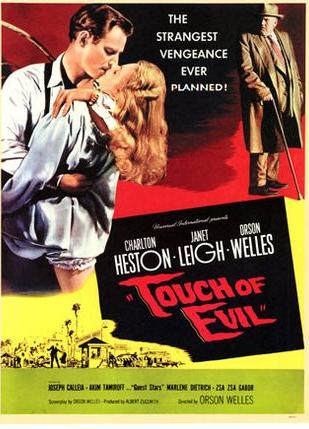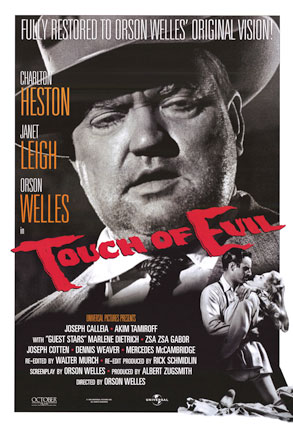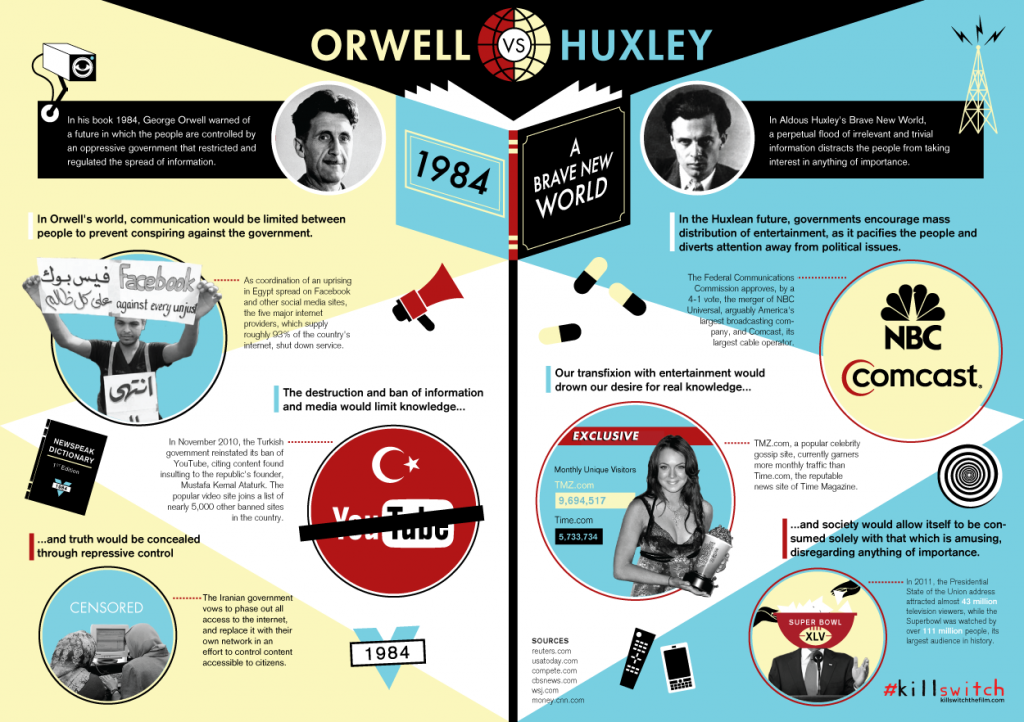The Orwell vs. Huxley Debate Revisited
July 27, 2011
I tend to fall on the side of Huxley as I believe the modern world most resembles his dystopian future rather than Orwell’s. Author Neil Postman made this case in his excellent Amusing Ourselves to Death and you can find a link to a cartoon version of his argument here, from an earlier post on this site. Promoters of the documentary film Kill Switch, about government control of the Internet, revisit this debate with the following infographic.
Click on image for larger size.
Why Are Americans Fat?
July 27, 2011
MPH Degree Programs.com, a guide to online programs for Masters in Public Health education offers the following infographic on What Keeps America Fat. It contains what I found to be some eye-opening statistics and (forgive me) food for thought.
Click on image for larger size.
PETA: By The Numbers
July 27, 2011
PETA (People for the Ethical Treatment of Animals) has a more extreme agenda than most casual observers probably realize. Their goal is for no human use of animals of any kind: not for food, not for clothing (leather and wool), not for medical testing or studies, not for entertainment (zoos, circuses, Sea World, etc.), not even as pets.
You have to admire the consistency of their world view, even if you disagree with them. The relationship between man and animal on this planet is largely the story of slaughter and exploitation. They’re certainly correct about that. But coming from a culture of omnivores in a country founded on the extinction of a native people, I wonder if PETA’s approach is viable. We don’t have the best track record for treating human beings, let alone animals and pets.
How many of their 2 million members would give up their own pets for the cause? How many would convert to veganism? Would it even be possible to end all animal farming and still feed the growing global population? Does owning a Labrador and enjoying a steak make one a hypocrite?
The following infographic makes the case against PETA. The controversy will continue, without doubt.
Click on image for larger size.
Dogs vs. Cats by the Numbers: What they Reveal About Us
July 27, 2011
Hunch.com is a site that “provides personalized recommendations from people you follow and makes customized predictions based on your interests” according to their home page.
I’m not certain I understand this mash-up of social, information and commerce but the following infographic is said to be based on over 80 million aggregated and anonymized responses to Hunch questions from 700,000 of its users. So that is a lot of data points, anyway. Just don’t take it too seriously.
Click on image for larger size.
Where Does Your Data Live?
July 27, 2011
The folks at Mozy, who offer online, off site “cloud” based storage for the data that lives as ones and zeros on your hard drives, MP3 players, SSDs, external drives and network back-ups have created an infographic that shows where your information is stored geographically (along with other interesting statistics). Fascinating stuff, I think.
Click on the image for larger size.
“Touch of Evil” – Opening Crane Shot
July 21, 2011
If you’ve never seen this late noir classic directed by Orson Welles, you’ve got a real treat in store. This post was inspired by a site that recently claimed to compile the 100 best scenes in American cinema.

Of course, anything like that is wildly subjective and open to serious debate. Let’s just say that my own list does not include Tom Cruise shouting, “Show me the money” or Sharon Stone’s crotch shot from Basic Instinct.
But one sequence on this list that would be not only in my personal top 100, but my personal top 5, too, is the opening of Touch of Evil. It’s brilliant technique and great visual storytelling. It’s the kind of thing that can only be done in film. And it’s one of the reasons true film geeks will always revere Welles.
Touch of Evil was edited without Welles’ consent priot to it’s original 1958 theatrical release. He wrote Universal a 58 page memo to correct these unwanted changes. In 1998 a ‘restored’ version was released that attempted to follow Welles’ memo. The opening sequence (above) had the film’s title’s removed and the original soundtrack restored, integral to being able to follow the movement of the car with the bomb.

Wings & Wheel at Sikorsky Airport 2011 3D Photos
July 20, 2011

On May 22 I attended the 2011 Wings & Wheels at Sikorsky Airport in Stratford, CT. The weather was not nearly as cooperative in years past and so I got fewer shots this time around. Here’s the best of it in anaglyph 3D. . .
Click on any image for large size light box style slideshow
Comic Book Economics: 3 Hours of Entertainment for $120. Is This Sustainable?
July 18, 2011
I’m a long time comic book fan, going back to the early 1960s. I agree with the late Harvey Pekar’s view that comics are words and pictures and, despite the medium’s fixation in America with long underwear super heros, there’s no inherent limitation in how good either the pictures or words can be.
Recently I went to a local comics shop and bought a first issue of Deadman and the Flying Graysons, part of the Flashpoint story arc.
 In order to read the entire Flashpoint storyline DC Comics requires the purchase of 37 comic books (with 18 pages of content each) at $2.99. With sales tax where I live this comes to a whopping $117.66!
In order to read the entire Flashpoint storyline DC Comics requires the purchase of 37 comic books (with 18 pages of content each) at $2.99. With sales tax where I live this comes to a whopping $117.66!
New York based artist Alex Katz once referenced a survey that claimed people at fine arts museum spent an average of 7 seconds looking at a painting. “I try to give them their 7 seconds worth,” he said. His works, like most painters, took weeks of effort to complete, and more often far longer than that.
The 18 pages of Flashpoint #1 took less than 5 minutes to read; a bit more perhaps if you linger over the art.
That works out to 3 hours and 5 minutes of reading time for close to $120.
By comparison, in 1965 an issue of Green Lantern had 21 full pages and 3 three-quarter pages of story and art. An issue sold for 12 cents. (Phun Phact: According to the US Bureau of Labor Statistics that 12 cents would be 86 cents today).
What else is competing for your entertainment dollars in today’s recession?
The popular video game Call of Duty: Black Ops retails for $60, provides a much more immersive experience and gamers can play this for dozens, and sometimes hundreds, of hours. The current box office blockbuster Harry Potter and the Deathly Hallows, Part 2 runs 2 hours and 10 minutes, the ticket price locally is $11.50 and it’s in 3D to boot!
Back to the saddle-stitched four color process product. Obviously, you can develop a far more complicated storyline given 666 pages rather than the 23 and 1/4 of the 1960s. And the production values of today’s comics are without question much improved in two areas: the quality of paper used and the complexity and subtlety of the coloring.
The basic art of penciling and inking may be better, in general, according to your taste. Although during their run on Green Lantern 46 years ago the combination of Gil Kane’s pencils and Sid Greene’s inks is the equal to anyone working today, in my opinion.
Certainly in most cases anatomy drawing has suffered as several generations of comic book artists have learned their figure drawing skills not from life but from aping the exaggerations of earlier comic book artists. For example, Gil Kane’s women are realistically sexy without the need for breasts larger than their heads.
My conclusion is that the current business model for selling ‘floppies’ or individual issues of comic books is unsustainable. As a fan I hope there is a way for the form to reinvent itself before it sucumbs to market pressures and the competition from other media.
Perhaps the move will be to digital distribution on tablet devices like the iPad, the current trend for the magazine industry in general. Will this mean the end of the ‘brick and mortar’ comic book specialty shop as it has for the bookseller Borders? Tune in next time: same Bat-Time, same Bat-Channel. . .
Hypoallergenic Dogs: “No Such Thing” says Recent Study
July 17, 2011
First, the caveats: as everyone should know by now, science does not consist of a single study. This one, by the Henry Ford Hospital in Detroit, found no scientific evidence that allegedly “hypoallergenic” dogs produce fewer allergens than other breeds.
The study sampled 173 homes with 60 different breeds of dogs, including 11 breeds considered hypoallergenic: Beddington Terrier, Bichon Frise, Chinese Crested, Irish Water Spaniel, Kerry Blue Terrier, Maltese, Poodle, Portuguese Water Dog, Schnauzer, Soft Coated Wheaten Terrier, and Xoloitzcuintli.
What are people allergic to? It’s not the fur or hair that accumulates throughout the house, it’s the dander, or dried flakes of your dog’s skin. Specifically, the allergen is a protein, found in both canine saliva and urine, that sticks to these dander flakes. That’s what causes the stuffy-runny nose-achy-sneezing-coughing reaction in humans.
One of the theories is that dogs who shed less or have hair that must be cut produce less dander, hence the current popularity of the cross-breed Labradoodle. The takeaway is that you may be able to reduce the effect somewhat, there are no dogs that are 100% allergen-free.
For more information, read this post on The Week’s site: “The ‘myth’ of hypoallergenic dogs.”
The Evolution of Web Design by KISSmetrics
July 17, 2011
KISSmetrics, an online marketing and customer acquisition blog, has a great infographic about the history and development of web design. There’s also a lot of solid content on their site that’s informed by the use of similar excellent infographics.
Well worthing checking out if you’d like to understand things like say, the most effective day and time to post on Facebook or how often you should Tweet.
Click on image for larger size.














